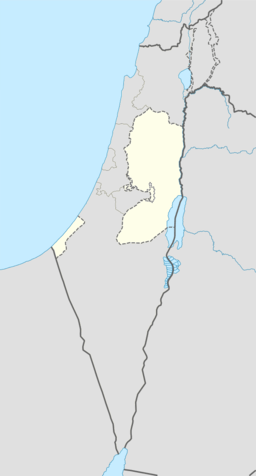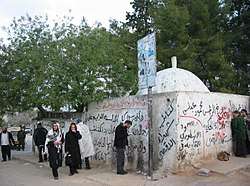Kifl Haris
Kifl Haris (Arabic: كفل حارس) is a Palestinian village in the northern West Bank, located six kilometers west of Salfit and 18 kilometers south of Nablus in the Salfit Governorate, northwest of the Israeli settlement city Ariel.
Kifl Haris | |
|---|---|
| Arabic transcription(s) | |
| • Arabic | كفل حارس |
| • Latin | Kifl Hares (official) Kefl Harith (unofficial) |
 View of Kifl Hares, 2011 | |
 Kifl Haris Location of Kifl Haris within Palestine | |
| Coordinates: 32°07′07″N 35°09′25″E | |
| Palestine grid | 165/169 |
| State | State of Palestine |
| Governorate | Salfit |
| Government | |
| • Type | Village council |
| • Head of Municipality | Ahmad Buziah[1] |
| Population (2007)[2] | |
| • Total | 3,248 |
| Name meaning | "The village of the guard"[3] |
History
Sherds from the Middle Bronze Age, Iron Age II, Persian, Hellenistic, Roman, Byzantine/Umayyad, Crusader/Ayyubid and Mamluk eras have been found here.[4]
Ottoman era
In 1517, the village was incorporated into the Ottoman Empire with the rest of Palestine, and in 1596, Kafr Harit appeared in Ottoman tax registers as being in nahiya (subdistrict) of Jabal Qubal, part of the Sanjak of Nablus. It had a population of 54 households, all Muslim. They paid taxes on occasional revenues, goats and/or beehives, and a fixed amount; a total of 22,500 akçe.[5] Sherds from the early Ottoman era have also been found here.[4]
In 1838, Edward Robinson noted it as a village, Kefr Harith, in the Jurat Merda district, south of Nablus.[6]
In 1870 Victor Guérin reached the village, after walking through "beautiful plantations of figs and olives". He estimated it had 600 inhabitants.[7] The name of this place was given to Guérin as Kefil Haris. The Wely marked on the Palestine Exploration Fund 1880s map as Sheikh Ata, 1 mile north-east of Kefr Haris, is called by him Sheikh Khather. He also calls attention to the remains of an old watchtower built of large, well-cut stones, between Deir Estia and Kefr Haris. At the latter place he found two broken marble columns built up in the wall of the mosque.[8]
In 1882, PEF's Survey of Western Palestine described Kifl Haris as a "somewhat small village on high ground, with olive groves to the east. It has three sacred places, Neby Kifl, Neby Nun, and Neby Lusha."[9]
British Mandate of Palestine era
In the 1922 census of Palestine conducted by the British Mandate authorities, Kufr Hares had a population of 373, all Muslim,[10] increasing in the 1931 census to 562 persons, still all Muslim, in 130 houses.[11]
In the 1945 statistics the population was 770 Muslims[12] while the total land area was 9,393 dunams, according to an official land and population survey.[13] Of this, 4,117 were allocated for plantations and irrigable land, 2,131 for cereals,[14] while 32 dunams were classified as built-up areas.[15]
Jordanian era
In the wake of the 1948 Arab–Israeli War, and after the 1949 Armistice Agreements, Kifl Haris came under Jordanian rule.
In 1961, the population was 1,341.[16]
post-1967
Since the Six-Day War in 1967, Kifl Haris has been under Israeli occupation.[17] Visits by Jewish pilgrims to Kifl Hares are coordinated by the Israeli military.
Tomb of Joshua

According to a Samaritan tradition, noted in 1877, the tombs of Joshua and Caleb were in Kifl Haris.[18]
Biblical tradition places the tomb of Joshua, Caleb, and Nun according to Joshua 24:30 in Timnath-heres which is attributed to be the current location of Kifl Haris. Thousands make the pilgrimage to the tombs on the annual commemoration of Joshua's death, 26th of Nisan on the Hebrew calendar.[19]
Israeli Palestinian conflict
According to the United Nations OCHA, three local residents were killed during the First Intifada and one during the Second Intifada.[20]
42% of the village land is classified as Area B land, while the remainder 58% is Area C. Israel has confiscated 361 dunams of land from Kifl Haris in order to establish the Israeli settlement of Ariel.[21]
On 14 March 2013,[22] Adele Biton was critically injured (later dying from her injuries), and her mother and two sisters were moderately injured, after their car crashed after Palestinians threw stones their way near the village.[23][24] Five youths from Kifl Haris were charged by a military court for responsibility for the incident, and as of February 2015 the case has not yet been concluded.[23]
In June 2014, Jamil Ali Abed Jabir died during a night raid by the Israeli army. Locals say he suffered a heart attack while defending his home. According to an Israeli army spokesman, his house wasn't raided.[25]
In 2015, an Israeli tour of the site was preceded by a convoy of military vehicles which closed off the town entrances and imposed a shutdown of all the village shops so Israeli tourists could visit the tomb for several hours.[26]
References
- Municipalities Archived 2007-02-21 at the Wayback Machine Nablus Municipality
- 2007 PCBS Census Archived 2010-12-10 at the Wayback Machine Palestinian Central Bureau of Statistics. p. 112.
- Palmer, 1881, p. 230
- Finkelstein et al, 1997, p. 460
- Hütteroth and Abdulfattah, 1977, p. 131
- Robinson and Smith, 1841, vol 3, Appendix 2, p. 127
- Guérin, 1875, p. 161
- Guérin, 1875, p. 161, as translated by Conder and Kitchener, 1882, SWP II, p. 324
- Conder and Kitchener, 1882, SWP II, pp. 284-285
- Barron, 1923, Table IX, Sub-district of Nablus, p. 25
- Mills, 1932, p. 61.
- Government of Palestine, Department of Statistics, 1945, p. 18
- Government of Palestine, Department of Statistics. Village Statistics, April, 1945. Quoted in Hadawi, 1970, p. 60
- Government of Palestine, Department of Statistics. Village Statistics, April, 1945. Quoted in Hadawi, 1970, p. 107
- Government of Palestine, Department of Statistics. Village Statistics, April, 1945. Quoted in Hadawi, 1970, p. 157
- Government of Jordan, Department of Statistics, 1964, p. 26
- Al Monitor 'War of the shrines' stirs tension between Palestinians, Israelis, al Monitor,
- Conder and Kitchener, 1882, p. 218 - 219
- "Jews Barred from Visiting Tomb of Biblical Joshua".
- "Kifl Hares village Profile" (PDF).
- Kifl Haris Town Profile, ARIJ, p. 17
- "Hundreds attend funeral for 4-year-old terror victim Adele Biton". Ynet.
- "Toddler dies two years after stone-throwing incident left her critically injured". Haaretz. 17 February 2015.
- "Israeli Girl Injured in Palestinian Rock-Throwing Attack in 2013 Dies". New York Times. 17 February 2013.
- "Israel rejects responsibility for elderly Palestinian's death". Ma'an News. 22 June 2014.
- 'Hundreds of Israelis visit West Bank tomb under armed guard,' Ma'an News Agency 27 February 2015.
Bibliography
- Barron, J.B., ed. (1923). Palestine: Report and General Abstracts of the Census of 1922. Government of Palestine.
- Conder, C.R.; Kitchener, H.H. (1882). The Survey of Western Palestine: Memoirs of the Topography, Orography, Hydrography, and Archaeology. 2. London: Committee of the Palestine Exploration Fund.
- Finkelstein, I.; Lederman, Zvi, eds. (1997). Highlands of many cultures. Tel Aviv: Institute of Archaeology of Tel Aviv University Publications Section. ISBN 965-440-007-3.
- Government of Jordan, Department of Statistics (1964). First Census of Population and Housing. Volume I: Final Tables; General Characteristics of the Population (PDF).
- Government of Palestine, Department of Statistics (1945). Village Statistics, April, 1945.
- Guérin, V. (1875). Description Géographique Historique et Archéologique de la Palestine (in French). 2: Samarie, pt. 2. Paris: L'Imprimerie Nationale.
- Hadawi, S. (1970). Village Statistics of 1945: A Classification of Land and Area ownership in Palestine. Palestine Liberation Organization Research Center.
- Hütteroth, Wolf-Dieter; Abdulfattah, Kamal (1977). Historical Geography of Palestine, Transjordan and Southern Syria in the Late 16th Century. Erlanger Geographische Arbeiten, Sonderband 5. Erlangen, Germany: Vorstand der Fränkischen Geographischen Gesellschaft. ISBN 3-920405-41-2.
- Mills, E., ed. (1932). Census of Palestine 1931. Population of Villages, Towns and Administrative Areas. Jerusalem: Government of Palestine.
- Palmer, E.H. (1881). The Survey of Western Palestine: Arabic and English Name Lists Collected During the Survey by Lieutenants Conder and Kitchener, R. E. Transliterated and Explained by E.H. Palmer. Committee of the Palestine Exploration Fund.
- Robinson, E.; Smith, E. (1841). Biblical Researches in Palestine, Mount Sinai and Arabia Petraea: A Journal of Travels in the year 1838. 3. Boston: Crocker & Brewster.
External links
- Welcome To Kifl Harith
- Kifl Haris, IWPS
- Survey of Western Palestine, Map 14: IAA, Wikimedia commons
- Kifl Haris Town (Fact Sheet), Applied Research Institute–Jerusalem, ARIJ
- Kifl Haris Town Profile, ARIJ
- Kifl Haris Town - aerial photo, ARIJ
- Development Priorities and Needs in Kifl Haris, ARIJ